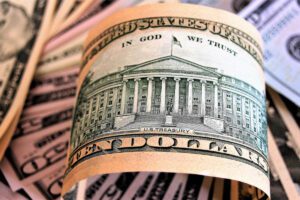
The major currency pairs were slightly changing during the trades on Monday.
The data published in the U.S. on Friday showed that inflation in the country remains high. This may prompt the Federal Reserve to raise interest rates to a higher level and not to lower them for a longer period of time.
Federal Reserve Bank of Cleveland President Loretta Mester said Friday that higher inflation points to the need to raise interest rates further. However, she refrained from speculating whether rates should be raised immediately by 50 basis points at the March meeting.
“The inflation numbers are still not where we need them to be,” she said in an interview with Bloomberg. The report is “consistent with the Fed needing to do a little more on the rate to make sure inflation slows again,” she said.
The euro is trading around $1.0542 in the morning versus $1.0547 in the previous session.
The value of the single European currency is now around 143.74 yen, up from 143.91 yen on Friday. The dollar is at 136.37 yen against 136.46 yen at the end of the previous trading day.
The DXY index, which shows the value of the U.S. dollar against six major world currencies, is up 0.06%. The WSJ Dollar, which tracks the dollar’s trend against 16 currencies, rose by a similar amount.
The pound is trading at $1.1938 compared to $1.1942 on the previous trading day. The euro is at Friday’s closing level of $0.8831.
“The environment is a bit nervous” as the market is unsure of the Fed’s future actions, noted Bank of Singapore currency analyst Moh Siong Sim. “Will they raise the rate by 25 basis points? Or will they be forced to increase the pace of the hike? There is no definite answer right now,” he said.
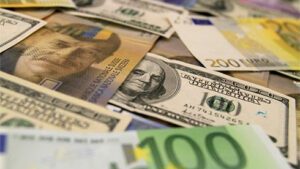
The U.S. dollar goes up against the euro, yen and pound sterling in trading on Friday on hawkish statements of Federal Reserve (Fed) executives, which strengthened traders’ opinion that the U.S. Central Bank is not going to stop the rate hike cycle yet.
Federal Reserve Bank (FRB) Cleveland President Loretta Mester said the day before that she had seen a “compelling case” for a 50 basis points (bps) rate hike at the January 31-February 1 Fed meeting.
The Federal Open Market Committee (FOMC) unanimously decided at that meeting to raise the rate by 25 bps, to 4.5-4.75% per year.
Mester still believes the Fed needs to raise the benchmark rate to more than 5% and keep it above that mark for a while to get inflation back under control.
St. Louis Fed Chairman James Ballard said Thursday that, like Mester, he supported a 50-bp rate hike at the last meeting. Neither Ballard nor Mester have a vote on the FOMC this year.
Ballard said he thinks the Fed should raise the rate to 5.25-5.5% and do it “as soon as possible. Thus, Ballard believes it is necessary to raise the rate by 75 bps from current levels, Market Watch notes.
“A further rate hike could help solidify the disinflationary trend in 2023 even as the economy continues to grow and the labor market is strong,” Ballard said.
The ICE-calculated index, which shows the dollar’s performance against six currencies (euro, Swiss franc, yen, Canadian dollar, pound sterling and Swedish krona), added 0.53% Friday, while the broader WSJ Dollar Index gained 0.38%.
The euro/dollar pair was trading at $1.0638 as of 7:45 a.m., compared with $1.0672 at market close Thursday.
The pound was down to $1.1948 from $1.1988 the day before.
The value of the American currency against the yen rose to 134.71 yen against 133.94 yen by the previous trading results.
The dollar/yuan pair is trading at 6.8755 yuan, compared to 6.8607 yuan on the previous day.
EURO, pound, U.S. dollar, yen
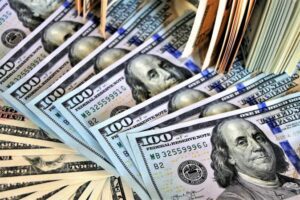
The US dollar is moderately declining against major world currencies on Thursday morning as investors are assessing U.S. economic data and its possible influence on the Federal Reserve’s (Fed) policy.
The index calculated by ICE, which shows the U.S. dollar dynamics against six currencies (euro, Swiss franc, yen, Canadian dollar, pound sterling and the Swedish krona), fell by 0.2% during morning trading. The day before the indicator reached its highest in five weeks.
The euro/dollar pair was trading at $1.0709 at 7:58 a.m. against $1.0688 at the close of Wednesday’s session, with the euro adding about 0.2%.
The day before, the U.S. Commerce Department reported that retail sales in the country rose 3% last month versus December, the fastest pace since March 2021.
Meanwhile, U.S. industrial production in January remained unchanged from the previous month, according to a Federal Reserve report released Wednesday. Experts’ consensus forecast called for an increase of 0.5%.
Recent statements from members of the Federal Reserve Board indicate that they generally support a further increase in the key interest rate to fight inflation. In particular, the head of the Federal Reserve Bank of Richmond, Thomas Barkin, and his colleague from the Federal Reserve Bank of Dallas, Laurie Logan, spoke about it.
Barkin said in an interview with Bloomberg that the Fed “needs to do more to fight inflation,” while Logan noted that the central bank “will have to raise the rate longer than previously expected.”
The pound sterling is up 0.1 percent, trading at $1.2049 versus $1.2032 at the close of last session.
The dollar-yen exchange rate is down 0.2% at 133.87 yen from 134.17 yen the day before.
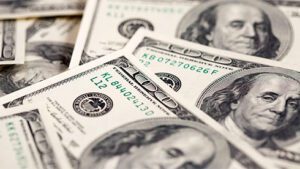
The U.S. dollar rose moderately against the euro and pound sterling Wednesday morning as traders assessed U.S. inflation data for January.
The ICE-calculated index, which shows how the U.S. dollar is performing against six currencies (euro, Swiss franc, yen, Canadian dollar, pound sterling and Swedish krona), is up 0.2% in morning trading.
The euro/dollar pair is trading at $1.0716 at 7:43 a.m. versus $1.0737 at the close of Tuesday’s session, the euro is losing about 0.2%.
As it became known the day before, consumer prices (CPI) in the U.S. rose by 6.4% in January compared to the same month last year. Thus, inflation slowed down from 6.5% in December.
However, analysts had expected a much more significant weakening in the pace of price growth, to an average of 6.2%, according to Trading Economics. The slower-than-expected slowdown in inflation raises the possibility that the Fed will continue to stay tight on monetary policy.
Now the market is waiting for U.S. retail sales data for January, which will be released at 4:30 p.m. Moscow time on Wednesday to better gauge the health of the U.S. economy. According to the consensus forecast, sales jumped 1.8% year-over-year last month after falling 1.1% in December.
The pound is 0.2 percent cheaper, trading at $1.2152 versus $1.2174 at the close of last session.
The dollar/yen exchange rate is at 133.05 yen compared to 133.12 yen the day before.
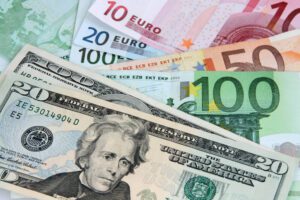
The U.S. dollar is getting stronger against the euro and the pound sterling in trading on Friday, getting cheaper against the yen.
The ICE-calculated index showing the dollar’s performance against six currencies (euro, Swiss franc, yen, Canadian dollar, pound sterling and Swedish krona) is gaining 0.07%, while the broader WSJ Dollar Index is up 0.08%.
The euro/dollar pair is trading at $1.0894 as of 8:00 a.m., up from $1.0911 at the close of the previous session.
The pound was down to $1.2212 from $1.2224 at the close of the previous session.
Both the European Central Bank (ECB) and the Bank of England raised key interest rates by 50 basis points (bps) on Thursday, with the European regulator saying it intends to raise them by the same amount at its next meeting in March.
Britain’s central bank lowered its inflation forecasts for 2023-2025, while ECB President Christine Lagarde said risks to both economic growth and inflation in the euro zone have become more balanced.
The day before the Federal Reserve raised its prime rate by 25 basis points. The rate had been raised 50 bps at the previous meeting and had been raised four times before by 75 bps.
The head of the US Central Bank Jerome Powell acknowledged at a press conference following the meeting for the first time that the “disinflationary process has begun”. He also said that the rate will not exceed 5% and reiterated that the Fed can achieve slowdown in inflation without causing significant harm to the economy.
The value of the dollar paired with the yen fell to 128.3 yen in trading on Friday, compared with 128.72 yen the day before.
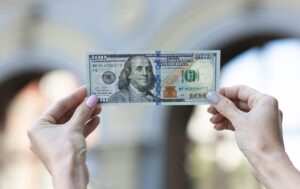
The U.S. dollar is moderately depreciating against major world currencies on Monday morning as investors continue to assess the dynamics of U.S. inflation and the future trajectory of the Federal Reserve’s monetary policy.
Meanwhile, trading volume in the foreign exchange market is lower than usual Monday as U.S. exchanges are closed in observance of Martin Luther King’s Day, Trading Economics noted.
The ICE-calculated index, which shows the U.S. dollar’s performance against six currencies (euro, Swiss franc, yen, Canadian dollar, pound sterling and Swedish krona), is down 0.23%, trading at its lowest in more than seven months.
Last week it was reported that consumer prices (CPI) in the U.S. rose 6.5% in December relative to the same month last year, slowing down from 7.1% in November. Inflation fell to its lowest level since October 2021.
A weakening inflationary pressure in the United States could be the decisive argument for a further slowdown in monetary policy tightening by the Federal Reserve.
The euro/dollar pair is trading at $1.0859 at 7:42 kk against $1.0833 at the close of last Friday’s session, the euro is adding more than 0.2%.
The dollar/yen exchange rate is down 0.1% at 127.71 yen from 127.86 yen at the end of last session.
The pound sterling is up 0.2% to trade at $1.2262 versus $1.2234 at the end of last week.
Meanwhile, the yuan, which is traded in mainland China, is at 6.7007/$1, up from 6.7030/$1 at the close of the previous session.
As it was reported the People’s Bank of China (NBK, the country’s central bank) on Monday injected 779 billion yuan ($116.2 billion) into the financial system within the framework of medium-term lending program (MLF).
Meanwhile, the rate on one-year loans under the MLF was kept at 2.75% per year, the NBK said in a statement. It remains unchanged for the fifth month in a row.